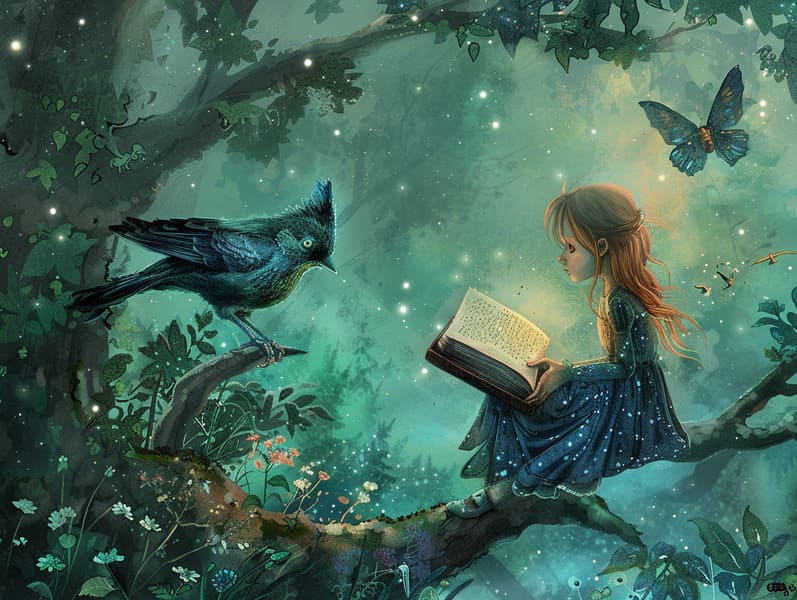
Timeless fairy tales have deep roots. These tales have been transmitted from one generation to the next centuries before they were ever inscribed. They were born from a variety of societies, including Indigenous traditions. They were initially told among older generations, often carrying themes and messages mirroring the societal norms and beliefs of the time.
The renowned Brothers Grimm, Jacob and Wilhelm, were among the first to compile many of these beloved tales. Their compilation, "Grimm's Folk Tales," included tales like "The Story of Cinderella," "The Story of Hansel and Gretel," and "Snow White," which have since become classics in the world of traditional fairy tales. Similarly, Hans Christian Andersen's magical fairy tales, such as "The Story of the Little Mermaid," and "The Duckling that Could," have touched hearts worldwide, establishing their place in the pantheon of treasured fairy tales.
Despite their age, fairy tales remain as applicable as ever, especially as kids' bedtime tales. These magical stories are now available in numerous formats, including gorgeously illustrated books, captivating animations, and digital fairy tales.
Their continued relevance can be attributed to several magical reasons:
Crucial Morals: Ancient fairy tales often offer important moral lessons. Stories like "The Shepherd Boy and the Wolf" teach the importance of truthfulness, while "The Race of the Tortoise and the Hare" illustrate the merits of persistence and unpretentiousness. These stories offer young readers clear distinctions between correct and incorrect, helping to shape their moral compass in a mild yet profound way.
Sympathy and Perception: Old fairy tales frequently showcase personalities facing problems and hurdles, encouraging young listeners to relate with their struggles and rally behind their triumphs. For instance, "The Tale of Beauty and the Beast" highlights the merit of seeing beyond looks to realize the inner spirit of a being, encouraging sympathy and awareness.
Cultural Insights: Many fairy tales are infused with the cultural contexts from which they came. Learning from these tales can provide captivating looks into different backgrounds, strengthening a sense of world respect and discernment.
Imagination and Creativity: The imaginative elements in ancient fairy tales—enchanted objects—fire up children’s inventiveness. These tales take readers to enchanted realms, stimulating inventive ideas and a sense of marvel that lasts a lifetime.
Classic fairy tales are not only whimsical but also didactic. They work as fantastical tools in fostering various cognitive and emotional skills in kids. When old fairy tales are spoken, they promote verbal development by showing new lexicon and intricate sentence structures. This practice also promotes listening abilities and attention span, as the young keep up with the story, keen to see what happens next.
Furthermore, reflecting on the themes and characters of fairy tales can nurture reasoning skills and thought processes. Little ones are guided to identify patterns, anticipate outcomes, and know cause and effect. These discussions also facilitate young ones verbalize their thoughts and feelings, fostering their emotional intelligence.
In today’s digital age, the more info proliferation of internet fairy tales has made these tales more acquirable than ever. Web platforms and web apps present large libraries of traditional fairy tales that can be perused or listened through anytime, anywhere. Fairy tales recited are particularly common, making available an captivating way for little ones to appreciate these bewitching tales. Voice books and read-out-loud videos lead characters and settings to life, often paired with entrancing background sounds and background music that amplify the narrative adventure.
The lasting allure of ancient fairy tales lies in their ability to shift to current eras while staying true to their core messages. Contemporary adaptations of these narratives often bring in more multicultural figures and modern settings, making them familiar to today’s audience. However, the fundamental themes of fortitude, warmth, and lawfulness remain unchanged, continuing to influence audiences of all ages.
Ancient fairy tales also offer a sense of coziness and homeliness. They highlight a structured narrative with a plain beginning, middle, and end, often concluding with the conclusion of conflicts and the triumph of virtue over wickedness. This dependability can be encouraging for children, spreading a sense of solidity in an fluid world.
Ancient fairy tales continue to delight and inform new generations, maintaining their mystique and applicability in modern society. As kids' bedtime tales, they serve a perfect blend of fascination and comprehension, nurturing moral values, empathy, and creativity. The proliferation of digital fairy tales and the widespread nature of fairy tales read aloud affirm that these timeless tales remain available to new generations.
By upholding and sharing these narratives, we continue to laud the rich tapestry of myths and cultural heritage. Whether you are enjoying a gorgeously illustrated book, enjoying a web collection, or listening through an read-aloud story, the loveliness of traditional fairy tales is always within reach. These stories teach us of the lasting influence of narratives and its ability to gather us across centuries and lands.
No matter if you are viewing a artistically illustrated book, discovering a internet collection, or listening via an voice book, the attraction of ancient fairy tales is always within reach.
These tales teach us of the consistent essence of tales and its ability to tie us across time and space, forming a connection that fascinates and enlightens alike.